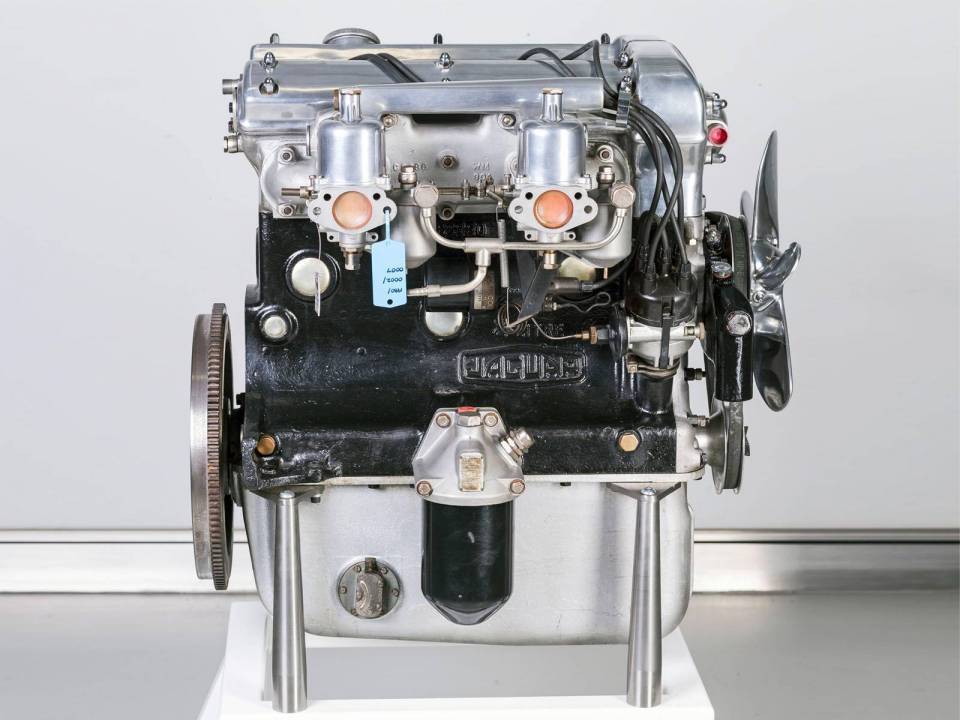Jaguar XK 4 Engine
4 Cylinder 2 Litre XK Engine
Production: 1948

Prior to World War II, SS Cars used three engines produced by the Standard Motor Company: a 1.5-litre 4-cylinder and 6-cylinder engines of 2.5 and 3.5 litres. Sir William Lyons and his engine designers; William Heynes, Walter Hassan, Claude Baily, and Harry Weslake are widely reported to have discussed a new range of replacements whilst fire-watching on the roof of the SS factory in Swallow Road, Coventry, during German World War II bombing raids. Rather than developing prototype engines immediately after the war, it is claimed that Jaguar's wartime engine developments went far beyond mere discussion and design, extending to the construction and testing of several prototype engines as early as 1943.
The initial aim was to produce a series of engines of higher than normal output that would be able to stay ahead of the competition without revision for many years and which Sir William insisted also had to "look good". In 1942-43, a range of configurations was considered and it was concluded that, for good breathing and high bmep, the new engines would need vee-opposed valves operating in hemispherical combustion chambers. Two configurations of this type were selected for comparison in 1943 and the prototypes named "XG" and "XF". The XG 4-cylinder of 1,776 cc, first tested in October 1943, was based on the 1.5-litre Standard block and used its single cam-in-block to operate the opposed valves via a complicated crossover pushrod arrangement, similar to that of the pre-war BMW 328. The XF 4-cylinder of 1,732 cc used the now familiar dual overhead cam (DOHC) configuration and was first tested in November 1944. The XG was found to suffer from excessive pushrod and rocker noise and gas flow figures through its vertical valve ports did not equal those of the horizontal ports on the XF. Therefore, from these two options, the DOHC XF layout was selected.
The first XK engine was not run until October 1945. This was XK Engine No. 1 – a four-cylinder unit with a three-bearing crankshaft, a bore and stroke of 76 x 98 mm and a capacity of 1,790 cc. The engine was still a small capacity unit similar to the XF, XG and even the pre-war Standard-SS Jaguar units. However, at this stage, even though Heynes mentions a six-cylinder version, tests appear to have been carried out on the four-cylinder XK which gave 76 bhp during early trials and later 83 bhp.
4 cylinder engine development progress:
- XG Pushrod engine 73 x 106 x 4 1776 cc May to Nov 1944
- XF 75 x 98 x 4 1732 cc Nov 1944 to Jun 1945
- XK1 (first of Heynes’ 4 x XJs) 76.25 x 98 x 4 1790 cc Oct 1945 to Nov 1946
- XK2 76.25 x 98 x 4 1790 cc Feb to Sep 1946
- XK3 76.25 x 98 x 4 1790 cc Dec 1946 to Feb 1947
- XK4 76.25 x 98 x 4 1790 cc Nov 1946 to Dec 1947
- Gardner Engine (used in record-breaking MG car) 1970 cc 1948
- XK Number 1 3-bearing crank 1970 cc 1949-1952
- XK Number 2 3-bearing crank 1970 cc 1950-1952
- XK 5-bearing crank 1970 cc 1953
The engine was further tested in its rebuilt form with various small modifications tried out. For example, in place of the twin SU carburettors, four Amal T.T.10 units were fitted on ‘a special monitoring plate with controls’. This was only tried once and by the next day the SUs were back in place to ‘prove the engine’. After being run for 13 hours 45 minutes the data was collated and the engine declared fit for purpose.
It was now ready to be fitted to the Gardner Special for the record attempt on 15th September 1948 – just before Jaguar announced the XK120 Super Sports with the six-cylinder XK engine at the Earls Court Motor Show.